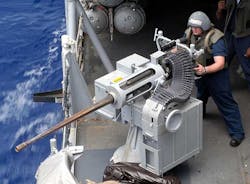Lockheed to develop smart bullets to help defend Navy vessels from swarming attacks
Officials of the U.S. Defense Advanced Research Projects Agency (DARPA) in Arlington, Va., made an $8.2 million order Friday to the Lockheed Martin Corp. Missiles and Fire Control segment in Grand Prairie, Texas, for phase II of the Multi Azimuth Defense Fast Intercept Round Engagement System (MAD-FIRES) program.
DARPA awarded an $8 million order last month to the Raytheon Co. Missile Systems segment in Tucson, Ariz., for MAD-FIRES phase II. The two companies won phase I contracts for the program in February 2016.
The MAD-FIRES program seeks to create a gun launched, medium caliber, guided, actively controlled projectile with significantly improved range and accuracy over current systems. It would combine the guidance, precision, and accuracy of missiles with the speed, rapid-fire capability, and large ammunition capacity of bullets fired from automatic weapons.
Related: Raytheon to build RIM-174 SM-6 shipboard air-defense missiles in $270.5 million contract
Attacks by unmanned aerial vehicles (UAVs), missiles, small planes, fast in-shore attack boats, and other maritime threats pose a deadly and evolving threat to ships and other maritime vessels, DARPA officials say.
These kinds of threats demand that Navy ships have access to leaded -edge defensive capabilities -- specifically an ability to engage multiple and diverse targets coming from a range of directions and do so rapidly and with high precision using current close-range shipboard gun systems.
MAD-FIRES aims to advance the state-of-the-art in defensive gun systems by creating a new, low-cost technological foundation for guided, gun-launched projectiles.
The program seeks to incorporate enhanced ammunition rounds able to alter their flight path in real time to stay on target, and a capacity to target, track, and engage several fast-approaching targets simultaneously and re-engage any targets that survive the initial engagement.
Related: Navy looks to BAE Systems for electronically steerable antennas for shipboard air defense
Raytheon and Lockheed Martin previously won MAD Fires phase-0 contracts to define concepts and establish a modeling and simulation baseline for the program. Phase-1 of the MAD-Fires program involved preliminary risk-reduction demonstrations.
Moving to phase II of the MAD-FIRES program, Lockheed Martin and Raytheon now will focus on projectile development and performance. A potential third phase would demonstrate the final MAD-FIRES technologies in an operational military environment.
On these contract modifications Lockheed Martin will do the work in Grand Prairie, Texas; Minneapolis; Montville, N.J.; Dallas; Brea, Calif.; Bethesda, Md.; Keyser, W. Va.; Marion, Ill.; and Westminster, Md, and should be finished in November 2017. Raytheon, meanwhile, will do its work in Tucson, Ariz.; Chelmsford, Mass.; and McKinney, Texas, and should be finished in March 2018.
For more information contact Raytheon Missile Systems online at www.raytheon.com, Lockheed Martin Missiles and Fire Control at www.lockheedmartin.com/us/mfc.html, or DARPA at www.darpa.mil.
Learn more: search the Aerospace & Defense Buyer's Guide for companies, new products, press releases, and videos
